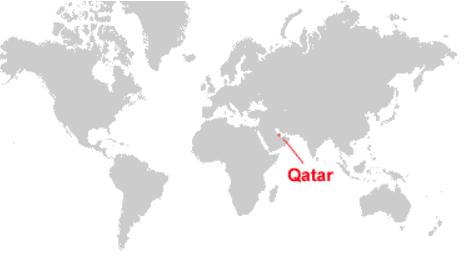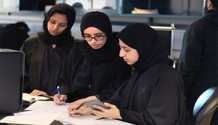by Arandeep Degun
Qatar lies on a peninsula in the Persian Gulf and shares a land border with Saudi Arabia. In size, it is roughly as big as the US state of Connecticut.

Qatar is a desert country and has only a limited natural water supply; thus, little agriculture or crop farming is possible. Only five percent of the land is used for agriculture such as date palm plantations. A very rich country due to its mineral resources, such as oil and natural gas, Qatar has the third largest gas reserves in the world. Instead of relying on its oil and gas reserves, however, it views education as the key to its future progress and realizes that success depends on the ability to compete in a global knowledge economy.
As gathered from UNICEF’s key messages, sustainable development encompasses a broad spectrum of economic, political and social aspects. Yet the critical determinant of long-term sustainability lies at the heart of developing human capital, where education acts as the primary lever for enhancing people’s capabilities as productive, engaged and capable citizens contributing fully to their families and societies.
As a small, rich developing country holding a leading role in the Arab world, Qatar has made significant efforts to improve the quality of its education system so that it can align with national priorities and international developments.
In launching its education reform, Education for a New Era, the government has taken bold steps to change the educational landscape in many areas and has made heavy investments in both K-12 and tertiary education, emphasizing the importance of human capital development. It calls for “educational curricula and training programs responding to the current and future needs of the labor market; high quality educational and training opportunities appropriate to each individual's aspirations and abilities; and accessible educational programs for life-long learning.”
While the reform is still moving forward, the change has been slow. Three main concerns that have a direct and indirect effect on the stakeholders and the community as a whole are highlighted below.
- Regardless of one and half decades of reform, the education system continues to face problems in challenging fixed mindsets and changing traditional attitudes. In particular, the new education reform stresses the development of creativity, critical thinking and inquiry. This requires freedom of thought, and it is contradictory to the philosophy of the Qatari Regime of Truth, where children learn not to question their teachers and parents, and parents learn not to question their leaders. Therefore, the movement toward critical thinking forces “the Qatari Regime of Truth to face cultural, political and religious challenges.” There is a great need to take into account the political, economic, social and cultural factors in order to develop a local educational reform that moves away from relying on models designed and implemented by and for Western countries. At this point, conducting a vertical study from K-12 to higher education and asking the stakeholders to identify the most challenging aspects in their learning and teaching will be of great value for designing innovative solutions to the educational issues in Qatar. While doing this, it is vital to determine how traditions, values and beliefs can coexist with the shifting winds of educational change. Otherwise, the reform might lose direction, “resulting in undesirable economic, educational and cultural consequences.”
- In relation to the results of both national and international assessments, the quality of K-12 education in Qatar is not good, and it does a poor job of preparing students for post-secondary study. Education reform is essential when students do not achieve the goals of education. Yet there is no such thing as a successful reform or a successful
 education system in isolation. Its content has to match with its participants, and change happens best when it is implemented effectively by the stakeholders on a daily basis. In this regard, teachers are the focal point in the success of any education reform. While teachers’ expertise and perspectives are essential in the development of educational innovations, most education reform fails to take teachers into account as the agents of change. In Qatar, teachers were not included in either the development of the reform or in the assessment of its implementation. Moreover, there is a growing body of research in Qatar confirming the lack of teacher qualification as one of the important factors influencing the proper implementation of the reform movement. Despite the government’s efforts, statistics show that most Qataris do not view teaching as an appealing profession, and there are relatively few Qatari teachers, especially at boys’ schools. Indeed, the majority of teachers are expatriates, mostly from other Arab countries, and more than 30 percent do not have formal qualifications in teaching. This context calls for a research agenda to rigorously examine the pre- and in-service teacher population in Qatar and determine their levels of motivation and self-efficacy as well as their attitudes toward teaching as a profession ‒ in addition to assessing how they perceive curriculum standards, students’ performance levels and the learning environment. The results of this analysis can provide insight into how to enhance pre-service teachers’ preparedness for real classroom settings and improve the quality of in-service teachers by tackling the challenges they face during their daily activities. As the quality of an education system is affected by the quality of its teachers, it is essential that Qatari people receive strong training in teacher education and develop beliefs and dispositions that are consistent with the existing educational policies. Thus far, Qatar University (QU) is the only higher education institute in the country that offers teacher preparation programs. In order to enhance the quality of the teaching workforce in Qatar, more local teacher candidates need to be trained and eventually replace the current expatriates. To this end, the government may need to grant other higher education institutions the right to launch teacher preparation programs and support the training of highly qualified local teachers who can uphold the education reform and deliver the curriculum standards as envisioned.
education system in isolation. Its content has to match with its participants, and change happens best when it is implemented effectively by the stakeholders on a daily basis. In this regard, teachers are the focal point in the success of any education reform. While teachers’ expertise and perspectives are essential in the development of educational innovations, most education reform fails to take teachers into account as the agents of change. In Qatar, teachers were not included in either the development of the reform or in the assessment of its implementation. Moreover, there is a growing body of research in Qatar confirming the lack of teacher qualification as one of the important factors influencing the proper implementation of the reform movement. Despite the government’s efforts, statistics show that most Qataris do not view teaching as an appealing profession, and there are relatively few Qatari teachers, especially at boys’ schools. Indeed, the majority of teachers are expatriates, mostly from other Arab countries, and more than 30 percent do not have formal qualifications in teaching. This context calls for a research agenda to rigorously examine the pre- and in-service teacher population in Qatar and determine their levels of motivation and self-efficacy as well as their attitudes toward teaching as a profession ‒ in addition to assessing how they perceive curriculum standards, students’ performance levels and the learning environment. The results of this analysis can provide insight into how to enhance pre-service teachers’ preparedness for real classroom settings and improve the quality of in-service teachers by tackling the challenges they face during their daily activities. As the quality of an education system is affected by the quality of its teachers, it is essential that Qatari people receive strong training in teacher education and develop beliefs and dispositions that are consistent with the existing educational policies. Thus far, Qatar University (QU) is the only higher education institute in the country that offers teacher preparation programs. In order to enhance the quality of the teaching workforce in Qatar, more local teacher candidates need to be trained and eventually replace the current expatriates. To this end, the government may need to grant other higher education institutions the right to launch teacher preparation programs and support the training of highly qualified local teachers who can uphold the education reform and deliver the curriculum standards as envisioned.
- Last, but certainly not least, in order for Qatar to be an advanced, self-sustaining country, it is vital that Qatari citizens have the knowledge and skills necessary to take charge of the country’s rapid growth. As Qatar diversifies its economy, more emphasis needs to be placed on subjects that propel a knowledge economy in areas such as science, technology, engineering and mathematics (STEM). Yet the results of both national and international tests and reports on education make clear that Qatari students, especially boys, are markedly lagging in mathematics and science subjects, not even meeting the national curriculum standards at all levels of K-12 education. As proficiency in STEM disciplines is a strong predictor of positive outcomes for young adults, influencing their ability to participate in post-secondary education and their expected future earnings in the long term, the underachievement of students in science and mathematics may cause Qatar to fall short in supplying enough qualified graduates in the STEM disciplines. Students’ decisions about their future fields of study are mostly based upon their attitudes toward a particular field, and educational polices play a vital role in developing, directing and sustaining these interests. Various actions can be taken to integrate STEM activities into the curriculums at different stages of education. Specifically, encouraging positive contact with science, technology, engineering and mathematics at early ages can have a long-lasting impact in increasing interest in these fields. Hence, the launch of the Secondary School Research Experience Program (SSREP) and the Middle School Science Challenge Program (MSSCP) are expected to be helpful in enhancing young Qataris’ interest in scientific fields, giving them initial experience in how to conduct a modest research project. It is also important to note that Education City, an initiative of the Qatar Foundation for Education, Science and Community Development, was established with the intention of preparing Qatari citizens for leadership roles in all sectors of life and providing a strong foundation for fields of importance to enhance economic growth. Knowing that science, technology, engineering and mathematics are central to Qatar’s economic development, a systematic study needs to be conducted to measure the impact of Education City in unlocking students’ potential for developing mathematical, scientific and technological literacy and competency. Additionally, in order to get a holistic view of the system, it is also important to examine how Education City partners with secondary schools to support STEM education; the role of the Ministry of Education and Higher Education in supporting teachers and principals in the implementation of quality STEM practices; and the role of Qatar University in preparing teacher candidates for providing successful STEM education at the K-12 level.
*This article has been adapted from: Koç, Muammer & Kayan Fadlelmula, Fatma. (2016). “Overall Review of Education system in Qatar” (Source #3 below).
Sources:
https://www.researchgate.net/publication/309479996_Overall_Review_of_Education_system_in_Qatar
https://www.unicef.org/agenda2030/files/Post_2015_Key_Messages_V07.pdf
Image: Qatari students at Education City in Doha.


